What was the original change?
Back in 2022 Salesforce announced changes were being made to the sync behavior options for the Opted Out field in Marketing Cloud Account Engagement1. Prior to the announcement, organizations were able to select the “Use the most recently updated field value” option for the Opted Out field in Account Engagement, which is by default mapped to the Email Opt Out field in Salesforce. However, the update would only allow organizations to select Salesforce or Account Engagement as the source of truth. No longer could the most recently updated value from either system be the source of truth.
In order to account for updates to the fields in both Salesforce and Account Engagement, and to be able to reference those values in both systems, Salesforce recommended a solution that involved creating two new fields: one in Salesforce and the other in Account Engagement. Here’s a diagram visualizing the necessary fields (new fields highlighted in green with generic names):

As you can see, each system will hold its own True/False value as well as the True/False value from the opposite system. However, this is problematic when organizations capture opt-ins and opt-outs in a variety of systems and rely upon the timing of those updates to determine the source of truth. Before you take immediate action keep reading on to learn about additional upcoming changes to determine which course of action is right for your company.
More changes are coming?
Yes, and it’s for the better in my opinion because it tackles the issue I just mentioned. Salesforce recently announced they are making an update on the sync behavior options for the Opted Out field in Account Engagement. Instead of limiting the Opted Out field to only regard Salesforce or Account Engagement as the source of truth, organizations will again have the option to indicate the most recently updated value, whether it’s Salesforce or Account Engagement, will be the source of truth.
According to the article the change will be available for organizations starting on June 13th, 2023, while the ultimate decision deadline is now October 18th, 2023.
The reason I really like this update is that there’s no need for additional fields and automations in both Salesforce and Account Engagement – you’ll just need to make a quick update to field tracking in Salesforce when that update is in place.
How do I make sure I’m good to go?
There’s a lot to unpack in the paragraphs above, and to make things more complicated, not all organizations are in the same position. Some may have already selected Salesforce or Account Engagement as the source of truth for the Opted Out field and therefore may have built out some additional automation in the two systems. Other organizations still might have the system with the most recently updated value serve as the source of truth (who said procrastination was a bad thing?). Regardless of where you are, here are the instructions to make sure you and your company are squared away.
For organizations that still have the “Use the most recently updated field value” option selected as the sync behavior for the Opted Out field
- Navigate to the Setup section in your Salesforce instance and click on “Object Manager”
- Search for “Leads” and click on that item.
- Click the “Set History Tracking” button on the right side of the page.
NOTE: If you don’t currently have Lead History enabled you’ll need to check the “Enable Lead History” checkbox. - Check the Email Opt Out field and click “Save.”
- Repeat the same steps for the Email Opt Out field on the contact object.
NOTE: Similar to the lead object when you don’t have Lead History enabled, click the “Enable Contact History” checkbox if you don’t have Contact History enabled. - On June 13th make sure the “Use the most recently updated field value” option is selected for the sync behavior for the Opted Out field in Account Engagement.
For organizations that designated Salesforce or Account Engagement as the source of truth sync behavior for the Opted Out field
- Create a field labeled “Account Engagement Opted Out” on both the lead and contact objects in Salesforce.
NOTE: Ensure the fields have the appropriate read/write settings configured. - Map the newly created lead field to the newly created contact field upon conversion.
- Make sure the Opted Out field in Account Engagement is mapped to the Account Engagement Opted Out field and Account Engagement is selected as the source of truth.
NOTE: You may need to refresh the Account Engagement metadata in order to see the Salesforce field in Account Engagement. - Create a prospect field labeled “SFDC Opted Out” in Account Engagement.
- Map the SFDC Opted Out field to the Email Opt Out field in Account Engagement and ensure Salesforce is selected as the source of truth.
- Create two flows (one for the lead object and one for the contact object) in Salesforce to update the Email Opt Out field when the value does not match the Account Engagement Opted Out field.
- Create two automation rules in Account Engagement to update the Opted Out field when the value does not match the SFDC Opted Out field (one to update to TRUE and one to update to FALSE).

- While you wait for the June 13th go-live date for the update to the sync behavior options, enable tracking on the Email Opt Out fields on the lead and contact objects.
- On June 13th, select “Use the most recently updated field value” as the sync behavior for the Opted Out field and map the Opted Out field to the Email Opt Out field.
- Deactivate the automation rules and flows you previously used to account for updates in both systems.
Conclusion
The Opted Out and Email Opt Out fields in Account Engagement and Salesforce, respectively, are vital to the compliance of your marketing strategy. With more and more tools being introduced to marketing tech stacks, this opens the door for inaccurate data processing causing multiple other errors downstream. However, by nailing down this process and making the necessary updates, you can ensure your organization is in a great position moving forward.
1In April 2022, Salesforce renamed Pardot to Marketing Cloud Account Engagement.







